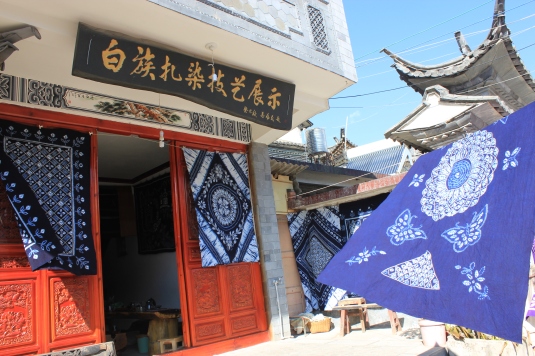Hi everyone, finally I am back from fieldwork in China and can update my blog from now on. I still cannot believe wordpress is blocked (like Facebook does) in China! Anyway, here I am~
My fieldwork in China was quite intense and now I am transcribing the interviews. Along with transcribing, I will post fieldwork story here bit by bit. I might lose my ability to speak English after 3 months in China, so bear with me and tell me whenever you spot a mistake. Thanks a million~
Today we are getting to know tie-dyeing. What is tie-dyeing? Let me show you a picture first:
According to Oxford Advanced Learner’s Dictionary, to tie-dye something is to make patterns on cloth by tying knots in it or tying string around it before you put it in a dye, so that some parts receive more colour than others.
The main Oxford Dictionary says to tie-dye is to produce patterns in (a garment or piece of cloth) by tying parts of it to shield it from the dye.
Wikipedia offered a rather confusing explanation which mixed tie-dyeing and other resist-dyeing techniques, but it got the technique right. The manipulations of the fabric prior to application of dye are called resists, as they partially or completely prevent the applied dye from colouring the fabric. Resist-dyeing techniques were found in Africa, Japan and South Asia – where Dali Zhoucheng Village (Yunnan Province, China) is.
Zhoucheng Bai Zu tie-dyed souvenirs plant a seed deeply in my heart when I travelled to Dali with my mom 17 years ago (1997). This traditional folk craft product of the ethnic minority Bai Zu somehow managed telling me how important authenticity is back that time. Bai Zu tie-dyeing is closely related to Bai Zu people’s life, linking various forms of traditional culture and cultural space. Also, it combined culture and art in one object; hence it has a unique and precious value and vital significance for both Bai Zu culture and Chinese culture as a whole.
The natural environment has deep influence on the ethnic nationality of Bai Zu people. Bai Zu people worship the colour white, so we are called Bai ethnic group – “Bai” means white in Chinese. “You can see our houses use white walls. We like wearing white clothes – our young people all wear white clothes. White means purity, honest and loyalty and integrity, etc., good characteristics, we worship these characteristics.” Yihui Chen, the heir of Blue-white Tie-dyeing House said.
It’s a Bai Zu ethnic tradition that young people wearing white clothes. People of Zhoucheng Village lived on hillside, they went to fields to get firewood, the indigo might coloured their white clothes, and then they discovered that the indigo can be dyestuff, and it can make beautiful blue background and white flowers cloth (Chen, 2015).
In 2006,Bai Zu tie-dyeing was listed in the first national nonmaterial cultural heritage lists (Intangible Cultural Heritage).
Now some Bai Zu tie-dyeing exist as souvenirs. In order to learn about the current situation of tie-dyed souvenirs, I decide to go to Dali again. Dali is a small and remote town in Yunnan Province (southwest China), which is an ethnic minority autonomous region inhabited by ethnic minority Bai Zu. Fieldwork site is Zhoucheng Village (see figure 2), the birth place of Bai Zu tie-dying, and naturally now the making place of most Bai Zu tie-dyeing souvenirs.
My fieldwork was carried in Blue-white Tie-dyeing House in Dali (the picture below), and my story is to be continued.




Recent Comments